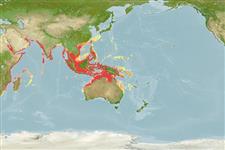Classification / Names
Common names from other countries
Main reference
Size / Weight / Age
Max length : 100.0 cm SL male/unsexed; (Ref. 188); max. published weight: 410.00 g (Ref. 4883)
Environment
Marine; pelagic-neritic; depth range 0 - 150 m (Ref. 30573)
Climate / Range
Tropical, preferred 27°C (Ref. 107945); 30°N - 30°S, 30°E - 162°E
Distribution
Indo-West Pacific: Red Sea and East Africa to the Solomon Islands, south to Australia (Ref. 33390). Questionably occurring in the Mascarenes (Ref. 33390). Probably similar to that of Chirocentrus dorab, but not always distinguished from that species (Ref. 188).
Countries | FAO areas | Ecosystems | Occurrences | Introductions
Short description
IUCN Red List Status (Ref. 115185)
Threat to humans
Harmless
Human uses
Fisheries: highly commercial
More information
Common namesSynonymsMetabolismPredatorsEcotoxicologyReproductionMaturitySpawningFecundityEggsEgg development
ReferencesAquacultureAquaculture profileStrainsGeneticsAllele frequenciesHeritabilityDiseasesProcessingMass conversion
Tools
Special reports
Download XML
Internet sources
Estimates of some properties based on models
Phylogenetic diversity index
PD50 = 1.0000 many relatives (e.g. carps) 0.5 - 2.0 few relatives (e.g. lungfishes)
Trophic Level
4.2 ±0.74 se; Based on food items.
Resilience
Medium, minimum population doubling time 1.4 - 4.4 years (K=0.24)
Vulnerability
Moderate to high vulnerability (53 of 100)
Price category
